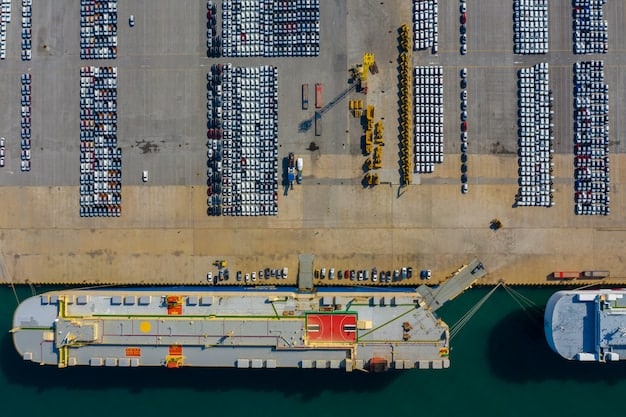How the Infrastructure Bill Will Reshape US Transportation & Logistics

How Will the Proposed Infrastructure Bill Affect Transportation and Logistics Nationwide? The bill allocates billions to modernize roads, bridges, ports, and public transit. These improvements promise to enhance efficiency, reduce congestion, and bolster supply chains across the United States.
The passing of the Infrastructure Investment and Jobs Act marks a pivotal moment for the United States. But how will the proposed infrastructure bill affect transportation and logistics nationwide? This legislation promises to inject billions of dollars into modernizing the nation’s infrastructure, and its impact on transportation and logistics could be transformative.
From upgrading roads and bridges to expanding public transit and enhancing ports, the bill aims to address long-standing infrastructural challenges. This article explores the key provisions of the bill and analyzes how they are poised to reshape the transportation and logistics landscape across the country.
How Will the Proposed Infrastructure Bill Affect Transportation and Logistics Nationwide?
The Infrastructure Investment and Jobs Act, often referred to as the Infrastructure Bill, is a comprehensive piece of legislation designed to overhaul and modernize America’s aging infrastructure. The bill allocates significant funding to various sectors, with a substantial portion directed towards transportation and logistics.
Understanding how will the proposed infrastructure bill affect transportation and logistics nationwide requires a closer look at its key components. The bill addresses critical areas such as road and bridge repairs, public transportation enhancements, upgrades to ports and airports, and investments in electric vehicle infrastructure.
Key Provisions of the Infrastructure Bill
The Infrastructure Bill includes several key provisions aimed at improving transportation and logistics infrastructure. These provisions cover a wide range of projects, from repairing existing infrastructure to investing in new technologies.
- Roads and Bridges: A significant portion of the funding is allocated to repairing and rebuilding roads and bridges. This includes addressing structural deficiencies, reducing congestion, and improving safety.
- Public Transportation: The bill provides funding for expanding and modernizing public transportation systems. This includes investments in buses, trains, and other forms of public transit.
- Ports and Airports: The bill includes funding for upgrading ports and airport infrastructure. This aims to improve efficiency, reduce bottlenecks, and enhance the overall capacity of these critical transportation hubs.
- Electric Vehicle Infrastructure: The bill invests in building a national network of electric vehicle charging stations. This supports the transition to electric vehicles and reduces reliance on fossil fuels.

These provisions are designed to address some of the most pressing challenges facing the transportation and logistics industry. By investing in these critical areas, the bill aims to create a more efficient, reliable, and sustainable transportation system.
In summary, the Infrastructure Bill’s key provisions target improvements across multiple facets of transportation and logistics, setting the stage for substantial nationwide changes. The question remains: exactly how will the proposed infrastructure bill affect transportation and logistics nationwide, and what specific outcomes can be expected?
Impact on Road and Bridge Infrastructure
One of the most significant aspects of the Infrastructure Bill is its focus on improving road and bridge infrastructure. Roads and bridges are the backbone of the nation’s transportation network, and their condition directly impacts the efficiency and safety of logistics operations.
So, how will the proposed infrastructure bill affect transportation and logistics nationwide with regard to roads and bridges? The bill allocates substantial funding to address the backlog of repairs and upgrades needed to bring these structures up to modern standards.
Reducing Congestion and Improving Safety
The improvements to roads and bridges are expected to have several positive impacts on transportation and logistics. These include reducing congestion, improving safety, and lowering transportation costs.
- Reduced Congestion: By addressing bottlenecks and expanding capacity, the bill aims to reduce congestion on roads and bridges. This can lead to faster delivery times and lower fuel consumption for trucking companies.
- Improved Safety: The bill includes funding for safety improvements, such as adding guardrails, improving signage, and upgrading lighting. This can reduce the risk of accidents and improve overall safety for drivers.
- Lower Transportation Costs: By improving the condition of roads and bridges, the bill can lower transportation costs for businesses. This includes reduced wear and tear on vehicles, lower fuel consumption, and fewer delays.
The improvements to road and bridge infrastructure are expected to have a ripple effect throughout the economy. By making it easier and safer to transport goods, the bill can support economic growth and create jobs.
Considering the magnitude of these potential improvements, it’s crucial to understand the larger picture of how will the proposed infrastructure bill affect transportation and logistics nationwide, especially over the long term.
Enhancements to Public Transportation Systems
In addition to roads and bridges, the Infrastructure Bill also focuses on enhancing public transportation systems. Public transportation plays a critical role in moving people and goods, especially in urban areas.
So, specifically, how will the proposed infrastructure bill affect transportation and logistics nationwide by enhancing public transportation? The bill allocates significant funding to modernize and expand public transit options across the country.
Modernizing and Expanding Public Transit
The bill includes provisions for modernizing existing public transportation systems and expanding access to new areas. This includes investments in buses, trains, subways, and other forms of public transit.
- Modernizing Existing Systems: The bill provides funding for upgrading existing public transportation systems with new technologies and equipment. This includes replacing old buses and trains with more efficient and environmentally friendly models.
- Expanding Access to New Areas: The bill supports the expansion of public transportation systems to new areas, especially in underserved communities. This can improve access to jobs, education, and other opportunities for residents.
- Integrating Different Modes of Transportation: The bill encourages the integration of different modes of transportation, such as buses, trains, and bike-sharing programs. This can create a more seamless and efficient transportation network for riders.
By enhancing public transportation systems, the bill aims to reduce traffic congestion, improve air quality, and provide more transportation options for residents. This can have a positive impact on the overall quality of life in communities across the country.
The planned updates to public transportation paint part of the overall picture of how will the proposed infrastructure bill affect transportation and logistics nationwide. These improvements aim to reduce traffic and provide alternative transportation options.
Upgrading Ports and Airports for Efficiency
Ports and airports are critical nodes in the nation’s transportation and logistics network. They serve as gateways for international trade and play a vital role in moving goods and people across the country.
An important consideration is, how will the proposed infrastructure bill affect transportation and logistics nationwide with regards to ports and airports? The bill includes funding for upgrading these facilities to improve efficiency, reduce bottlenecks, and enhance overall capacity.

Reducing Bottlenecks and Enhancing Capacity
The bill allocates funding to address some of the most pressing challenges facing ports and airports. These include reducing bottlenecks, enhancing capacity, and improving security.
- Reducing Bottlenecks: The bill provides funding for projects that can reduce bottlenecks at ports and airports. This includes expanding terminals, adding new loading and unloading equipment, and improving traffic flow.
- Enhancing Capacity: The bill supports projects that can enhance the overall capacity of ports and airports. This includes building new runways, expanding storage facilities, and upgrading technology.
- Improving Security: The bill includes funding for security enhancements at ports and airports. This includes upgrading security equipment, improving surveillance systems, and increasing staffing levels.
By upgrading ports and airports, the bill aims to improve the efficiency and reliability of the nation’s transportation and logistics network. This can lead to faster delivery times, lower transportation costs, and increased competitiveness for American businesses.
Improvements at ports and airports are part of the overall focus of how will the proposed infrastructure bill affect transportation and logistics nationwide. These enhancements promise reduced congestion and increased capacity.
Investing in Electric Vehicle Infrastructure
As the world transitions to electric vehicles, it is essential to invest in the infrastructure needed to support this shift. The Infrastructure Bill includes significant funding for building a national network of electric vehicle charging stations.
When asking, how will the proposed infrastructure bill affect transportation and logistics nationwide, considering electric vehicles is essential. The bill aims to accelerate the adoption of electric vehicles and reduce reliance on fossil fuels.
Building a National Network of Charging Stations
The bill provides funding for building thousands of electric vehicle charging stations along highways and in urban areas. This aims to make it easier for drivers to charge their vehicles and reduce range anxiety.
The national charging network aims to boost the adoption of electric vehicles. By placing charging stations strategically, it addresses a significant obstacle for potential EV owners and promotes sustainability.
This section highlights another critical aspect of how will the proposed infrastructure bill affect transportation and logistics nationwide, paving the way for more sustainable transportation options.
Conclusion
In conclusion, understanding how will the proposed infrastructure bill affect transportation and logistics nationwide reveals its potential to modernize and transform the US infrastructure landscape. By allocating billions to critical areas, the bill addresses long-standing challenges and paves the way for enhanced efficiency, safety, and sustainability.
From repairing roads and bridges to expanding public transportation and upgrading ports, the Infrastructure Investment and Jobs Act aims to create a more robust and reliable transportation network across the country. The investments in electric vehicle infrastructure further underscore the bill’s commitment to a cleaner and more sustainable future. The Act promises significant and wide-ranging improvements.
| Key Point | Brief Description |
|---|---|
| 🛣️ Road & Bridge Repair | Funding to rebuild and repair, reducing congestion and improving safety. |
| 🚆 Public Transit Modernization | Investments in buses, trains, and expanding access in underserved areas. |
| 🚢 Port & Airport Upgrades | Projects aimed to relieve bottlenecks and increase capacity. |
| ⚡ EV Infrastructure | Building a national network of EV charging stations. |
Frequently Asked Questions
The Infrastructure Bill allocates significant funds to repair and rebuild roads nationwide. This means fewer potholes, smoother surfaces, and safer driving conditions for all motorists.
Yes, the bill aims to reduce traffic congestion by improving roads, bridges, and public transportation systems. These upgrades will help to ease bottlenecks and improve traffic flow.
The bill invests in modernizing and expanding public transit, offering more options for commuters. This should help alleviate congestion and reduce reliance on individual vehicles, especially in urban areas.
Upgrading ports and airports improves efficiency, reduces delays, and enhances capacity. This makes it easier to move goods and people, facilitating international trade and domestic travel.
Building a national network of charging stations encourages the adoption of electric vehicles. A robust charging infrastructure reduces range anxiety and supports the transition to more sustainable transportation options.





